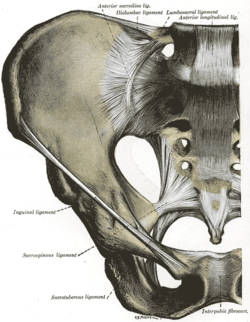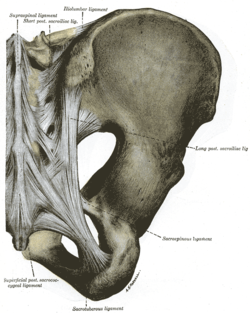

| Iliolumbar ligament | |
|---|---|

Articulations of pelvis. Anterior view (iliolumbar ligament labeled at center top)
| |

Articulatios of pelvis. Posterior view (iliolumbar ligament labeled at center top)
| |
| Details | |
| From | Transverse process of fifth lumbar vertebra |
| To | Posterior part of iliac crest |
| Identifiers | |
| Latin | ligamentum iliolumbale |
| TA98 | A03.2.07.002 |
| TA2 | 1853 |
| FMA | 21493 |
| Anatomical terminology | |
The iliolumbar ligament is a strong ligament[1] which attaches medially to the transverse process of the 5th lumbar vertebra, and laterally to back of the inner lip of the iliac crest (upper margin of ilium).
The ligament extends inferolaterally from its medial attachment,[1] radiating laterally.[2] It represents the thickened inferior border of anterior and middle layers of thoracolumbar fascia. Inferiorly, the ligament is partially continuous with the lumbosacral ligament[1] (which may be considered an inferior subdivision of the iliolumbar ligament).[3]
The ligament's medial attachment is at the apex[4][2] and anteroinferior aspect of the transverse processoflumbar vertebra L5 (and occasionally an additional weak attachment at the transverse process of L4).[2]
Laterally, the ligament attaches onto the posterior part of the inner lip of the iliac crest.[1] More precisely, its lateral attachment is by two main bands:[2]
During in newborns and children, this structure is in fact muscular; the muscle tissue is then gradually replaced by ligamentous tissue until the fifth decade of life.[2]
Occasionally, a small ligamentous band stretches from the apex of transverse process of L4 inferior-ward to the iliac crest posterior to the main ligament; usually, fibrous strands are found between this latter process and the iliac crest, but these are only considered a true ligament when dense enough.[1]
The iliolumbar ligament strengthens the lumbosacral joint assisted by the lateral lumbosacral ligament, and, like all other vertebral joints, by the posterior and anterior longitudinal ligaments, the ligamenta flava, and the interspinous and supraspinous ligaments.[4] It reduces the range of movement of the lumbosacral joint.[6]
{{cite book}}: CS1 maint: location missing publisher (link)
|
| |||||||||||||||||||
|---|---|---|---|---|---|---|---|---|---|---|---|---|---|---|---|---|---|---|---|
| Vertebral |
| ||||||||||||||||||
| Thorax |
| ||||||||||||||||||
| Pelvis |
| ||||||||||||||||||